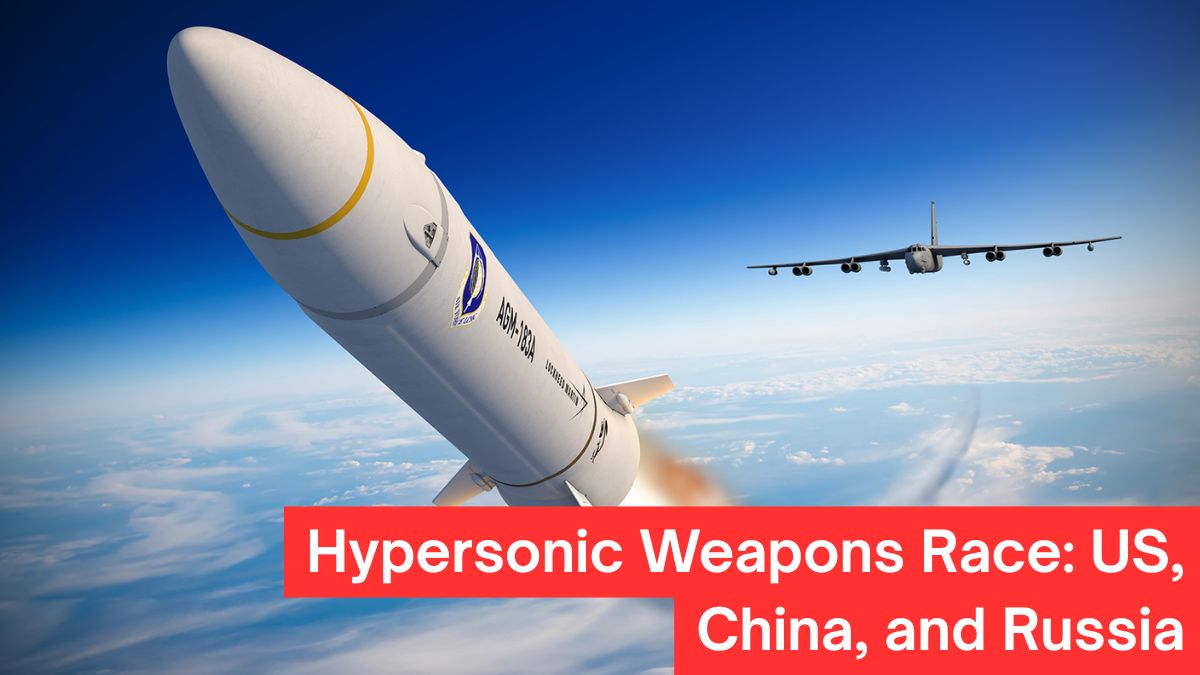Hypersonic weapons Race: US, China and Russia Developments and the Detection Challenges The global race to develop hypersonic weapons, which are capable of surpassing Mach 5 (3,858 miles per hour) is changing the nature of strategic plans for military operations and is causing a rise in geopolitical tensions.
China, Russia, and the United States are the primary rivals and China along with Russia currently ahead in terms of deployment as well as the US is behind because of program setbacks.
Problems with detection caused by the speed of these weapons, their maneuverability, as well as low-altitude trajectories have raised fears about stability in the strategic environment and the possibility of an unstabilizing arms race.
Here is a look at advances, detection issues and their implications in light of the information provided and other sources.
Advancements in Hypersonic Weapons China
- Leadership in deployment China is widely considered to be the leading technology provider in hypersonics operating systems, such as that of the DF-17 hypersonic glider (HGV) which was unveiled in the year 2019 and the more advanced GDF-600 which was revealed in the latter half of 2024, with a payload of 1,200kg and Mach 7 capabilities (Competitor 1 Data). Public opinion about X emphasizes China’s fielded system and anti-hypersonic defenses. This is evident in the recent testing of an ICBM equipped with a hypersonic boost-glide warhead mounted on an inclined course in September 2025, designed to avoid US security systems for detection in Asia-Pacific (Data).
- Technology Edge: China’s innovations include the possibility of hypersonic air-to-air missiles that could target US bombers and a possibility of technologies sharing Iran as well as Russia (Data). Its Xing Kong 2 (Starry Sky-2) waverider, which was tested in 2018 is expected to become operational by 2025 and the DF-ZF is coupled to the DF-17 (Competitor 2).
- Strategic Implications: China’s arsenal including sub-munition capabilities, pose an imminent threat to US naval forces within the South China Sea and beyond and could be a challenge to US defensive missiles (Competitor 1, Competitor 3).
Russia
- Operations Systems Russia uses systems similar to that of the Kinzhal (Mach 10,) along with the Zircon (Mach 9) anti-ship cruise missiles, both of which are used in Ukraine and Russia, with the latter sporting plasma shrouding which disrupts the locks on radars, making it virtually uninterceptible by NATO systems such as Patriot, THAAD, or Aegis (Data, Competitor 1). The Avangard HGV, which is capable of speeds as high as Mach 12. (potentially Mach 27), is designed to thwart US defensive missile systems (Competitor 1 Competitor 2).
- Experimental Innovations Research and Development Oreshnik missile, which was tested to Mach 11 in the month of November 2024, has been deemed the next big thing, due to its warhead technology fragmented and the potential for mass production (Data Competitor 1.). X opinions praise Russia’s actual use of advanced metallurgy and continuous hypersonic flight. They dismiss US efforts as obsolete (Data).
- Strategy Posture: The Russians’ ultrasonic capabilities, based in Kaliningrad could pose a threat to NATO countries, and increase its capability to target assets of high value with little notice (Competitor 1.).
United States
- Development Delays Development Delays: The US is still in the lagging position, with no hypersonic systems in operation. It is believed that the AGM-183 The ARRW programme was cancelled because of test failures and the Army-Navy traditional hypersonic missile test at Cape Canaveral shows progress (Data). This Dark Eagle program aims to increase deterrence, however its full deployment is a long way off (Competitor 1.).
- Private Sector Work companies such as Stratolaunch have conducted tests on an experimental weapon called the Talon-A with Mach 5+ and offer the possibility of field-ready weapons, but not currently (Data). The US has put in $1.2 billion into its prompt strike program, and the request for $202 million in the year 2018 (Competitor 3.).
- Strategies for the Future: Analysts believe that the US is five to ten years behind, and are calling for rapid prototyping as well as defenses such as those of the Glide Phase Interceptor to counter the anti-access/area denial (A2/AD) dangers (Data). The UK is one of the US allies, is more far behind, with tests conducted in conjunction with the US that show progress, but no deployment-ready systems (Competitor 1.).
Other Players
- Israel, Iran, North Korea, France, India, Japan: Israel’s Arrow 3 is an ultrasonic interceptor, and Iran boasts of having hypersonic capabilities, however, its June 2025 missile was not able to maneuver properly (Competitor 1.). North Korea is developing hypersonic weapons from 2021 onwards, and France, India, Japan as well as Australia are working on similar technologies, typically to serve civilian needs (Competitor 1 and Competitor 2.).
Detection ChallengesHypersonic weapons pose unprecedented challenges to detection and interception due to their speed, maneuverability, and flight profiles:
- Low-Altitude Trajectories: Hypersonics like HGVs and cruise missiles travel at altitudes of 30 to 95 km beneath radar horizons, and evading systems such as Patriot, THAAD, and Aegis up to the point of the flight (Data, Competitor 1). Their non-parabolic, erratic paths make it difficult to track (Competitor 1 and 3.).
- Plasma Shrouding Russian Zircon makes use of plasma clouds to interfere with radar locks, making the radar almost unnoticeable (Data). The high temperatures and speeds cause nonlinear airflows, which can cause problems with the aerodynamic process and detecting (Competitor 2.).
- Hypersonics can compress warning durations to minutes, causing problems for decision-making processes, such as that of OODA Loop (Competitor 2.). For instance hypersonic missiles could change targets mid-flight e.g. shifting targets to Los Angeles to New York and leave defenders in uncertainty until the final period (Competitor 2).
- Ineffective Defenses: Systems like the S-300 struggle to maneuver objects, but even more advanced lasers aren’t equipped with the range or the irradiation duration to fight the hypersonic effect effectively (Data). It is reported that the US Congressional Research Service (February 2025) states that the sensors that are currently in use on earth and in space are not sufficient (Competitor 1.).
- Ideas for Solutions call for more advanced radars HF/VHF for stable cross-sections of radar (RCS) sensors that are space-based to overcome the limitations of ground radar as well as quantum technology for early warning (Data 1 Competitor). Attacks by electronic and cyber-physical means against enemy command and control systems can also reduce hypersonic efficiency (Competitor 2.).
Strategic and Geopolitical Implications
- The Arms Race And Escalation Risques The hypersonic race has fueled fears of a fresh Cold War-like arms race which is causing a reduction in response times, which increase the chance of miscalculation or preemptive attacks (Data, Competitor 3). The combination of the nuclear and conventional hypersonic abilities creates the possibility of misattribution. For instance, conventional strikes could be misinterpreted as a nuclear strike, leading to nuclear reaction (Competitor 3).
- Strategic Stability. Hypersonics may threaten the survival of nuclear deterrents because their capability to attack ICBM silos, command and control systems or even command and control can prompt nations to adopt hair trigger postures or delegate launch authority increasing instability in crisis (Competitor 2. Competitor 3.).
- Proliferation Risks: Beyond US, China, and Russia the proliferation of hypersonic technology into countries like Iran as well as North Korea could destabilize regional balances, allowing less powerful powers to be a threat to important ones (Competitor 3.). Rand report (2017) warns of a Rand Report (2017) cautions against a 10-year time frame to stop the spread of hypersonic technology (Competitor 3).
- Proposed Mitigations: Options include multilateral export control as well as data exchanges based regarding hypersonic plans, as well as including HGVs in arms agreements such as New START (Competitor 3). However, experts such as James Acton doubt the feasibility of a ban on testing due to the difficulty in defining moving vehicles that re-enter (Competitor 3.). Non-proliferation agreements or arm control are recommended to avoid destabilization (Competitor 2.).
Public and Expert Sentiment
- X Sentiment: People on X are awestruck by China along with Russia’s speedy advancement often slamming US delays as being based heavily on “1950s-level tech” (Data). Russia is seen as a leader in deployment and implementation, while China’s advances are seen as a danger to US assets, including bases and aircraft carriers within the Asia-Pacific.
- Expert Concerns such as William Freer and Sidharth Kaushal insist on the transformational potential of hypersonics, but warn against exaggerating the impact of their technology by pointing out that defenses like space-based sensors and directed energy weapons could help to reduce the threat (Competitor 1.). However, the absence of countermeasures in the current system that are acknowledged by US officials such as General John Hyten, underscores the need for innovation (Competitor 2.).
Conclusion
China and Russia lead the hypersonic weapons race with operational systems like the DF-17, Kinzhal, Zircon, and Oreshnik, while the US struggles with canceled programs and delayed deployments.
Detection challenges, driven by low-altitude maneuvers, plasma shrouding, and short warning times, render existing defenses like Patriot and Aegis largely ineffective, necessitating advanced radars, satellite systems, and quantum technologies.
The race risks escalating global tensions, with potential nuclear miscalculations and proliferation threats. Urgent innovation, arms control, and confidence-building measures are critical to mitigate these risks and preserve strategic stability.








